Speculation on the Cuban Internet backbone
Since the earliest days of the Internet, Cuba has stressed geographically distributed connectivity, unlike most developing nations, which focused on one or a few large cities. That policy is still in effect. There are plans to connect universities, schools and homes and there are already public WiFi hotspots and and Internet-access rooms in every province. (Of the original 118 public access rooms, only 12 were in Havana).
A backbone network covering the length of the island is necessary to achieve such geographically dispersed connectivity and, since essentially all of Cuba's international traffic is now routed over the undersea cable connection at the east end of the island, there must already be a backbone network connecting the provinces. The provision of 1 mbps international connectivity at the new WiFi hotspots is further evidence of a backbone.
I know nothing of the architecture or technology (fiber and wireless?) of today's backbone, but the load is very light compared to a future with planned traffic from homes, schools, universities and public access locations, so Cuba must be planning a high speed backbone.
We got a very hazy view of that plan in a Cuban market research study, which was just published by Nearshore America. The report includes diagrams of the three-phase backbone plan shown below:
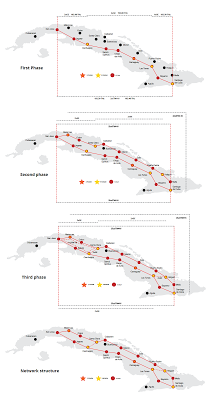
These diagrams are attributed to ETECSA, but they have been substantially redrawn to protect the identity of the person who supplied them. While the legend on each slide shows 2 fixed and 9 reconfigurable multiplexers, I suspect that refers to the final phase. Similarly, I am guessing that "12 OLA" refers to optical wavelengths in each network link, but that is just a guess. The author of the Nearshore report was not told the time schedule for the phases.
I'd be curious to know a lot more, like who is designing and installing the backbone and who is supplying the equipment -- for example, are those Huawei multiplexers?
The one thing these images show us is that ETECSA is indeed planning a fiber backbone network.
-----
Uodate 8/20/2015
@yawnboy sent me a link to material released by Edward Snowden showing that the NSA was thinking of installing back doors in Huawei routers in 2010.
An NSA presentation included this slide:
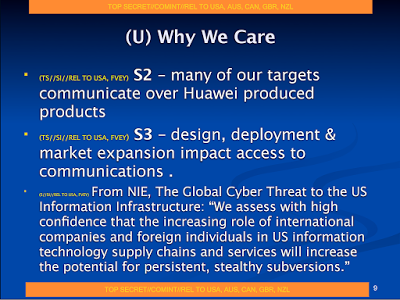
The text note accompanying the slide reads in part:
Many of our targets communicate over Huawei produced products, we want to make sure that we know how to exploit these products - we also want to ensure that we retain access to these communication lines, etc.I'm offering this in jest, but it would have been ironic if Cuba had installed Chinese routers with NSA "backdoors."
-----
Update 8/28/2015
Reader Ed Francis sent me a link to a 2005 post on Chinese companies in Cuba. The author visited the offices of several Chinese companies, including that of Huawei. The following is a Google Translate version of his observation:
Huawei to enter the Cuban market in 2000, when the company won the bid in an international tender Huawei Cuban government for the construction of a national fiber transmission network are conducted. Although the company is currently in Cuba only two market development officer and six engineers responsible for technical support, but Huawei's products have entered the all Cuban existing telecommunications.It sounds like he is saying that Huawei won a bid for the construction of a fiber backbone in 2000. No details are given, but I wonder if that may be referring to the network pictured above.
Huawei's office, Interim Head of Cuban Mr. Humberto said Cuba telecom market competition is very fierce, before the market is mainly occupied by Alcatel, Ericsson and other large companies in Europe, I would like to win the market from their hands share of easier said than done. However, with a strong technical strength and highly competitive prices, Huawei has basically heard from a Cuban company became a pivotal role in the market. Cuba Telekom AG is the only company operating fixed telephone service, the total investment in 2004 to purchase 30% of Huawei's products.
The article also says Huawei has an office with two market development officers (salesmen?) and six engineers, headed by a Cuban, Mr. Humberto. (It is my understanding that Chinese infrastructure projects are typically run and staffed by Chinese, which would make this an exception).
I checked on the Huawei and Cuban Chamber of Commerce Web sites, and there is no listing for a Huawei office in Cuba today; however, ZTE does have an office in Havana. (ZTE sold ETECSA 5,000 home modems for the planned DSL rollout and may also be seeking to sell backbone equipment).
Subsequently, an anonymous Cuban writer told me that:
In early 2000 gradually they replaced all Cisco router by Huawei, including my office. probably today 95% of all routers in Cuba are Huawei, a "legacy" of Ramiro Valdez was minister, and the millions that Cuba spent in the "battle of ideas.". He also said Huawei's office was located in the Miramar Trade Center).
-----
Update 8/31/2015
Ed Francis has continued his detective work. On LinkedIn, he found that Jorge Rivero Loo has, since 2008, supervised the implementation and technical support of the optical backbone network outlined above. The network uses Huawei equipment and Mr. Rivero has worked for them since 2002. Before that, he worked for ETECSA and studied at Jarcov University (in Russia?) and CUJAE.
Have US firms missed the boat?
-----
Update 9/8/2015
Ed Francis has turned up more evidence of Huawei equipment -- a Cubatel photo gallery from 2008. Here is one of the photos, along with its caption:
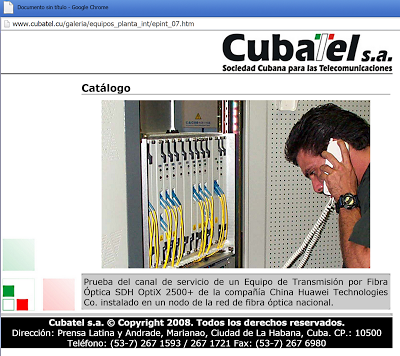
A second photo refers to speeds of 2 and 34 Mb/s:

This facility is referred to as a "node on the national fiber optic network," and, given the year and speeds, I suspect this equipment may have served a metropolitan area network -- perhaps in Havana?
-----
Update 9/21/2015
Jon Williams, @WilliamsJon, and Michael Weissenstein, @mweissenstein, demonstrated the existence of the high-speed backbone between Havana and the undersea cable landing when they discovered that extra bandwidth had been allocated to access points used by journalists during the Pope's visit:
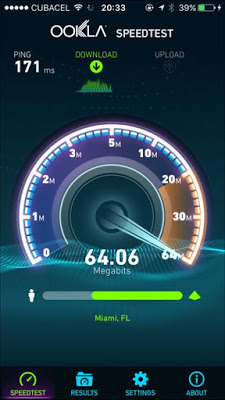 |
| 64 Mb/s from a mobile connection |
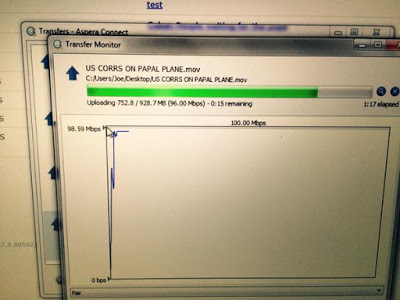 |
| 100 Mb/s from a wired PC |
- Cuban International Traffic Shifts From Satellite To The Alba-1 Undersea Cable
Doug Madory, Director of Internet Analysis at Dyn Research, sent me a note on Cuba's international traffic. As you see here, on July 1, nearly all satellite traffic (blue and green) was re-routed to the ALBA-1 undersea cable: As a result, median...
- Cuba Connecting Universities With Fiber
Is this the start of a fiber backbone? Walter Baluja, Director of the Computer Science Department of the Ministry of Higher Education has announced that starting January of 2016 all academic centers in the country will have access to fiber connections....
- A Leaked Etecsa Presentation On Home Internet Connectivity In Cuba
I don't criticize to knock the system down. On the contrary, I criticize to perfect the system. Carlos Alberto Pérez This post has taken several twists and turns. I started out to write a post commenting on an ETECSA PowerPoint presentation on their...
- Cuba's Wifi Access Plan Raises Intresting Questions.
Do we see the outline of a future national fiber backbone? Luis Manuel Díaz Naranjo, ETECSA Director of Communications, has announced that during the coming weeks, they plan to roll out 35 WiFi access points. As shown here, they will be distributed throughout...
- Chinese Technology Companies In Cuba -- What Are They Doing?
Jennifer Hernandez of the Institute for Cuban and Cuban-American Studies at the University of Miami has posted a note on her research on Chinese Technology Companies in Cuba. She notes that "through bilateral trade agreements, China has been expanding...
